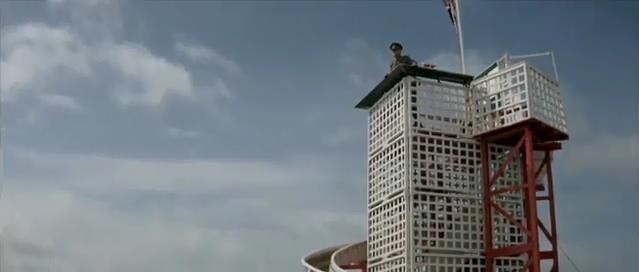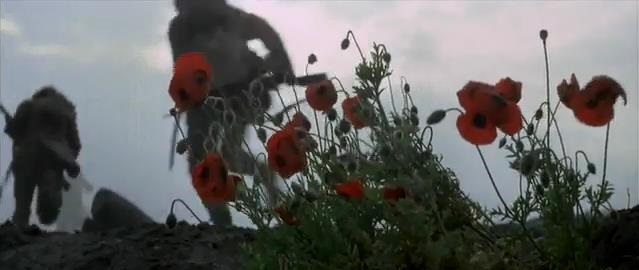Oh! What a Lovely War

The experience of
war poets, one of whom is represented, shows a vast incompetence laid at the feet
of the General Staff here, and most particularly Sir Douglas Haig, with the
tacit compliance of Lloyd George in the “war of attrition” left to
account for grand strategy that accomplished nothing. In his next film,
Attenborough shows Kitchener dropping Lieutenant Churchill’s book in the
rubbish.
At the beginning
and the end, the powers (an Austrian design upon Serbia is the motus).
The British
holocaust in World War One, its name is up in lights.
A specific war
drama, most specific, comprehensively grasped by Variety at once, it
seems, while Canby (who tells us the Broadway show was nothing like this) was
off-put and dubious of it by dint of the “contemporary” dilemma.
Later critics
have followed this split, so that the film is more fully understood by some and
not at all by others.
The title
sequence gives the form, a direct slide from proper politics and social
ebullience into Flanders fields, as at Brighton.
Vincent
Canby of the New York Times, “a big, elaborate,
sometimes realistic film whose elephantine physical proportions and often
brilliant all-star cast simply overwhelm the material with a surfeit of good
intentions.” Roger Ebert (Chicago
Sun-Times), “the war as a British music hall review.” Variety, “can
be labelled with such debased showbiz verbal coinage as fabulous, sensational,
stupendous, etc. It also happens to be dedicated, exhilarating, shrewd,
mocking, funny, emotional, witty, poignant and technically brilliant.” Time
Out, “lots of contemporary songs.” TV Guide, “not a flawless film but is thoughtful and
enthralling.” Catholic News Service Media Review
Office, “ambitious but largely successful”. Hal Erickson (Rovi), “an every-man-for-himself adaptation”.

Young Winston
A round joke on
the Prime Minister, delivered in the very best of styles, and that is saying
nothing.
Except that he
was a genius of sorts, by his own account, modest enough as these things go.
A biography as
fine as any, a peerless film, except that the British were at this time making
such films.
Variety is correct, “a brilliant artistic
achievement and a fascinating, highly enjoyable film,” adding
effervescently, “a combination not always obtained.”
Ebert was on the
side of the offscreen press interlocutors in this film (onscreen in Chaplin)
who wanted “the human being behind the historical façade”.
Canby went rather
balmy, describing it as “a movie for selected Tories—those who
don’t go to movies much.”
And this also was
the fate of other British film biographies at this time, critically speaking.
Time Out Film
Guide is quite gaga on it,
“a frightfully Boering biopic”.
A Bridge Too Far
A mile away,
which suggests Frend’s Scott of the Antarctic.
The Longest
Day is often brought in as a
comparison, but note that here only the operational leaders are seen, not the
brass at SHAEF.
A succession of
images, Eindhoven-Nijmegen-Arnhem, Operation Market Garden.
The central
sequence is a short masterpiece in its own right, the American sergeant who has
“guaranteed” his captain against death.
The final image
of a Dutch home turned into a lazaret and graveyard leads to the departure of
its occupants across the screen in a long shot taken from Jewison’s Fiddler
on the Roof.
Critics were
unanimously overwhelmed by the scale of incident and filming.
Magic
Ah, tricks,
they’re explained, you prepare them beforehand.
The art of the ventriloquist-magician
is more than a talent agency (even William Morris), more than her husband
(James Dean in his youth), more than the artist, who kills himself to leave
behind a plaything for his high school crush, a wooden heart.
That’s Magic,
though critics have always thought it’s quite something else, about a
deranged puppet.
Attenborough’s
direction is truly extraordinary in its two grand displays of virtuosity, a
seamless and imperturbable scenic construction, if one may say so, that affords
a multivalency of all the images.
It takes things
in its stride, “Gangrene” the agent (“that’s why they
call me The Postman, I always deliver”) and Peggy Ann Snow the girl and
Duke the husband get full measure and then some, not to mention Corky Withers
the nervous performer whose dummy is Fats, a wag.
Gandhi
The first part of
a satirical trilogy whose middle term is Cry
Freedom, it ends in Grey Owl.
Attenborough’s
subjects are not mocked, but a certain mystique appertaining to them, and this
we ascribe to the counterculture.
The magnificent
technique has been noted, what are described as excusable or damning flaws in
the telling are the missing element from all reviews, the satire.
So it will be
noted that this is not an answer to Cukor’s Bhowani Junction, nor anything to do with David Lean, but
Attenborough’s unique deadpan view of great events in the mind of men.
Another trilogy
might be discerned, Young Winston
followed by Chaplin and finally Shadowlands, where the figure of C.S.
Lewis is evidently not a portrait.
A Chorus Line
They say Hair
killed the Broadway show, the corpse is still Jazzercizing around the chairs in
elimination rounds, Glengarry Glen Ross and La Cage aux Folles
and Hurlyburly are right down the street.
The choreographer
is like Nurse Diesel whipping out the fruit cup of fame or withholding it. If
you wanted Phil Donahue scored by Marvin Hamlisch, you got it, sung with power,
powersung.
Andrew Lloyd
Webber, eat your whatever out.
Many, many, many,
many, many tickets were sold, we’re told, and it won the Tony and the
Pulitzer, too.
Fosse and Fame
go up the flume alike. Oh, Calcutta! in motley rehearsal togs, bared
breasts and bare stage.
It’s the
sort of thing that gives dullness a good name, and maybe even a national tour.
That infinitely hollow
triumph of showfolks, artistically the equivalent of dancing in the shower.
And then
there’s the joke about the arranger who went a bridge too far.
Those Springtime
for Hitler auditions.
Very cleanly
directed by Attenborough (screenplay by Arnold Schulman). Critics thought
(Ebert didn’t) it was better on Broadway, where (Canby says) there was a
certain “implication”.
Cry Freedom
Facts in the
matter of Steven Biko brought to light by extraordinary circumstances. The
material is treated as a primary document, a simple report. Biko might be this,
that or anything. His death in police custody is not absolutely unequivocal.
The subsequent “banning” of a newspaper editor provides the
essential corroboration.
So for the form,
the structure is the editor’s personal account of his acquaintance with
Biko, his tangles with the law, and the necessity of leaving South Africa to
publish his book.
Critics generally
disagreed with this structure and form, preferring to see a film called Biko.
The technique is to
fragment the material in single notes that draw their meaning from the rest,
not unlike Dmytryk’s Back to Bataan.
This is a characteristic of Attenborough’s style, it sustains a great
deal of discourse and meaning without any difficulty.
The liberal editor,
beguiling Biko, throngs at Soweto casting off Afrikaans (schoolchildren
ruthlessly murdered), a great hallucination.
Chaplin
Chaplin in the
hands of his biographers, two points tending toward the work.
This makes for a
film that is fundamentally half-assed for this purpose, to see the life (by
Attenborough’s art) and the Life at odds somehow.
A major work of
art, to be sure, on a great artist in the decline of biography. Attenborough
addresses himself to the problem between Fellini’s Intervista and
Harris’ Pollock.
This meant
nothing to the critics, absolutely nothing.
It is to be
remarked how steadily the film advances toward its revelation of Oscar clips,
less and less of the obtruding nonsense, more and more of the real Chaplin, as
the point draws near.
Edgar Allan Poe
is not so much thought of lately as deranged, and Shakespeare hardly ever as a
poacher.
Shadowlands
Nary a critic has
divined that this is mainly Goodbye, Mr. Chips, though many have noticed
it also makes one weep. Losey’s Accident, of which John Simon
observed that it is “meaningless”, actually provides the inner
structure.
It gets to the lacrimae
rerum, Baudelaire’s nobility of which Mallarmé was so careful, by way
of Cocteau’s Orphée and other things it is not, Pollack’s The
Way We Were, for example, and the wedding of Sherlock Holmes, nor Ted
Hughes and Sylvia Plath, and a satire of Oxford, which it partly is anyway by
dint of exactitude, and so forth.
It is extremely
refined and perhaps badly made expressly to get at the thing itself, which is
another way of calling a spade a spade, except that there isn’t another
way.
No more can be
asked of any motion picture, the fine performances have all been noted in
reviews.
To give an idea
of the extremely intricate nature of the workings would be very difficult, the
title is one key. It’s where the grass isn’t greener, that
Herefordshire valley in a nursery picture was Heaven all unseen when Mummy died
and the light went out, Mrs. Lewis takes him there, a place misnamed from the
Welsh, and so on, she dies, the fictional feisty C.S. Lewis takes care of her
son.
“That’s
what they come here for, the ritual.”
In Love and War
If you were to
remove Hemingway’s art from A Farewell to Arms, as an experiment,
say, you would have Forrest Gump.
That is probably
overstated, but the humor remains. Some effort was required to overcome the
natural tendency of the material to resist such treatment, but that’s the
gusto and dedication of it.
Grey Owl
The phony
half-breed from Hastings, who lived in the wild as an Ojibway and eventually
wrote and lectured as a crusader for Canadian beaver, “The Modern
Hiawatha”.
Attenborough’s
sendups are always built on his proper technique, a dry porous sand that does
not impede the action.
Herzog’s Grizzly
Man takes up the note, an openhandedness of stark incredulity.
George
Fenton’s fake music is the imitation maple syrup over it all.
Critics took it
at face value and were, how should one say it? Disappointed.